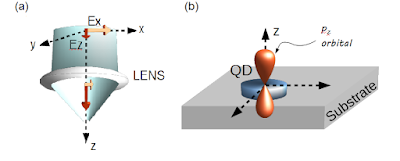In a previous post in quantum dot (QD) excitation we learned that twisted light adds versatility to the control of the electronic states. We studied the situation where the beam of twisted light satisfies the paraxial approximation. In this case, the light beam has significant electric and magnetic field in the direction perpendicular to the propagation direction $\hat{z}$, and can produce non-vertical heavy-hole to conduction bands transitions. By focusing the TL beam we gain even more control on the states of the dot, thanks to the enhancement of the electric field along $\hat{z}$.
A tightly-focused beam of twisted light presents a strong component in the direction of propagation (Fig 1a). For $\ell =1$ and $\sigma=-1$ the electric field $\mathbf E_z (\mathbf r, t)$ dominates the interaction [2] and is in fact constant close to $r=0$: $E_z (\mathbf r, t) = - E_0 \cos (\omega t - q_z z)$.
 |
| Figure 1: a) By focusing the beam the $E_z$ component of the electric field becomes larger. b) Light hole in a QD, showing its $p_z$ orbital. |
$$
|LH+\rangle = -1/\sqrt{6} [(|p_x\rangle + i |p_y\rangle)\downarrow - 2 |p_z\rangle)\uparrow] ~~~~~ (1)
$$.
 |
| Figure 2: The $E_z$ (blue arrow) interacts with the $p_z$ LH orbital and induces a light-hole valence to conduction band transition. |
Let's briefly recall what happens in the transition from heavy-hole states. We studied in Part 1 the optical excitation by a paraxial beam, i. e. one that only has in-plane components of the fields (and in this respect like a plane wave). Since the heavy hole wavefunction contains $p_x$ and $p_y$ orbitals the conduction($s$)-to-valence matrix elements $\langle s| x | p_x \rangle \neq 0$ and $\langle s| y | p_y \rangle \neq 0$: a paraxial beam produces HH-conduction band transitions. This transition creates an exciton with angular momentum AM$=1$ - combination of conduction-band electron spin AM and HH band+spin AM.
A paraxial beam can also excite a LH, producing a LH-exciton with angular momentum equal to $1$. Figure 3 shows the transitions using plane waves (solir black) and twisted light (dashed blue). Note that twisted light adds envelope AM.
In contrast, the $z$ component of a focused beam couples to the $p_z$ orbital part of the LH state. Note from Eq. (1) the different way in which spin is combined with band AM. The result is an exciton with zero band+spin AM ! (red arrow in Fig. 3)
References
[1] G. F. Quinteiro and T. Kuhn, Phys. Rev B 90, 115401 (2014).
[2] We said in a previous post that anti-parallel beams may have dominant magnetic field. In the particular case studied here, the electric field dominates.







0 comments:
Post a Comment